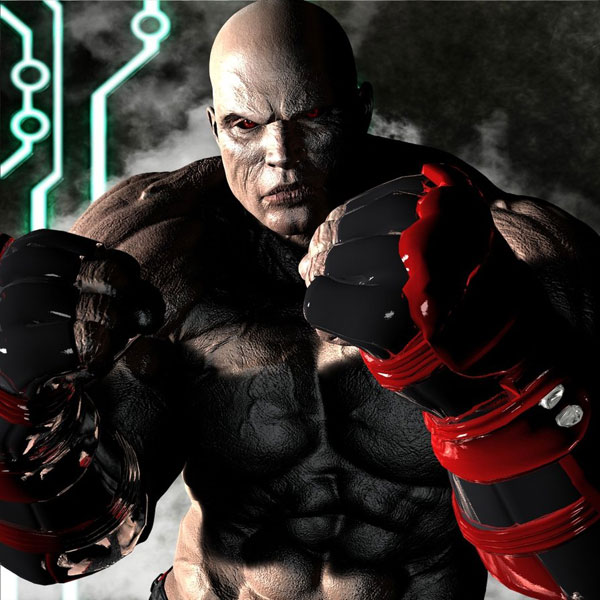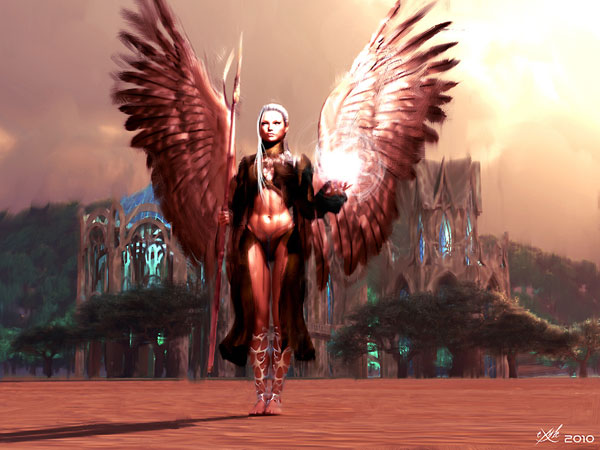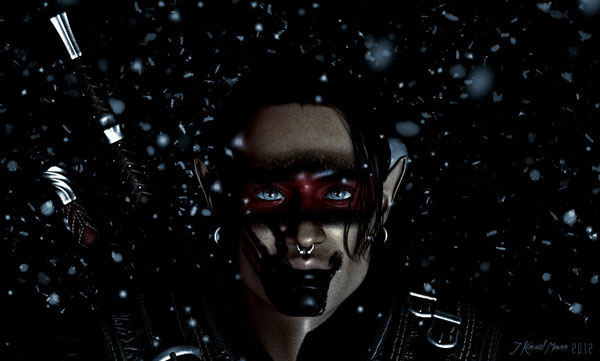 Jeremy Mowen was one of the first friends I made in the Poserverse. He was one of those cool guys with an awesome gallery that doesn’t mind slumming with the initiates and sharing his thoughts and knowledge. Getting any sort of feedback in a crowded environ like deviantART is a rare business, especially for those among the endless ranks of lowly newbs, so I always enjoyed talking shop with someone that had a good head start on me. Eventually we moved to exchanging correspondence and WIPs via email and began collaborating on joint projects, all of which have languished long in a mutually agreed murk and may never see the light of day in their fully intended forms.
Jeremy Mowen was one of the first friends I made in the Poserverse. He was one of those cool guys with an awesome gallery that doesn’t mind slumming with the initiates and sharing his thoughts and knowledge. Getting any sort of feedback in a crowded environ like deviantART is a rare business, especially for those among the endless ranks of lowly newbs, so I always enjoyed talking shop with someone that had a good head start on me. Eventually we moved to exchanging correspondence and WIPs via email and began collaborating on joint projects, all of which have languished long in a mutually agreed murk and may never see the light of day in their fully intended forms.
One of the primary factors in this agreed stasis was Jeremy’s shifting efforts to push out his literary/graphical chimeras before they wither on the vine. The foremost front runner in his undertakings is the Autumn Risen (set amidst a cataclysmic war-torn US), with Revenant emerging out of the frozen wastes of distant UV Prime.
Jeremy primarily works with Poser and Photoshop, but he also makes heavy use of DAZ Studio, Vue, and Reality 3D among others. Whatever the programs used you will notice bold contrasting colours, grungy vivid postworking techniques, strange beings and flawed heroes, big weapons, and lots and lots of wings.
J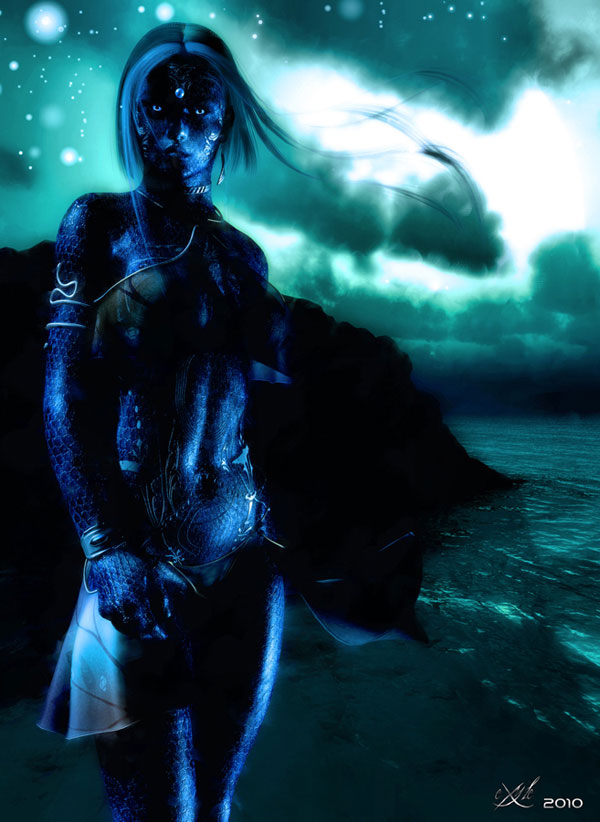 im: If I understand correctly, you took up 3D art (setting out with Poser?) as a way of creating artwork for your stories. How exactly did this path open up? Was the graphic novel always something you wanted to pursue?
im: If I understand correctly, you took up 3D art (setting out with Poser?) as a way of creating artwork for your stories. How exactly did this path open up? Was the graphic novel always something you wanted to pursue?
Jeremy Mowen: Even from the time I was a kid in grade school, I think telling stories graphically was always what I had at heart. At that time I was working with traditional media, mostly pencil and pen, and the things to emulate at the time were comic books and comic strips (I don’t think the term “graphic novel” had quite been coined yet). So yeah, there was most definitely a lot of emphasis on storytelling in my childhood years. I’d say when I was about 21, that’s when it really hit me that I somehow wanted to do a graphic novel down the road. I had just seen James O’Barr’s “The Crow” series compiled as a single graphic novel, and that idea really captivated me… telling a full length story, but completely illustrated.
At the time, of course, I had no idea what the future would hold. The Windows operating system was just coming onto the scene and things like Photoshop and Poser were not on the radar yet. It wasn’t until 1998 that I got my first PC and experienced Photoshop Essentials for the first time. That was a game changer for me. From that point on I went almost completely digital with my art, learning all that I could. Around 2005 just by chance I came across a demo of Poser 4 and I knew instantly this was going to open up entirely new creative possibilities for me. About a year or so later I found the program Vue 5. It seemed I had found the perfect synergy for digital illustration at that point: Poser for the characters, Vue for the “digital nature” / environments, and Photoshop to add the polish in post work. So yeah, 2006 is really when the workflow came together. I bit the bullet and bought brand new copies of Poser 6 and Vue 5 and the adventure began
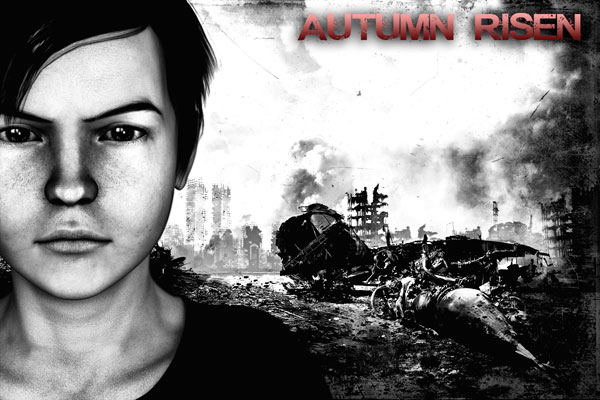
Jim: You are currently putting a lot of your time into Autumn Risen (formerly Mad World). Without giving away too much, what can you tell us about the story?
JM: Certainly, First of all let me clarify what Autumn Risen is exactly in terms of a medium. I currently have two novels in progress, Autumn Risen and Revenant, with Autumn Risen currently being the primary focus. Revenant, a sci-fi / survival-horror story, is being developed in the format of a traditional graphic novel. Autumn Risen, however, is something different. It’s a bit of a grand experiment for me and I’m hoping it’s a refreshing change from the ordinary to the readers. Autumn Risen is being written as a full length novel (as in a written novel, not a graphic novel). However, I have always had the desire to create a “hybrid”… something with the length and depth of a written novel, but with the beautiful full page illustrations found in some of the best graphic novels. So with Autumn Risen, you get the best of both worlds; deep story and character development and full page cutting edge digital illustrations of many of the key moments and scenes from the book.
In regards to the story itself, we are looking at a scenario in near-future America. Various political tensions have caused civil strife within the country itself as well as with certain foreign factions that would like nothing more than to see the U.S. fall. Two of these groups (I won’t spoil those here) form a jagged alliance which serves both of their interests. Taking advantage of destabilized military situation in the U.S. due to civil conflict, this coalition enacts a two pronged attack. Members of the smaller power infiltrate the US with a genetically engineered virus which has basically been spliced together and mutated from the Rabies virus, Encephalitis, and several strains of Influenza. The result is a pathogen which has a rapid onset and renders its host extremely aggressive, delusional, unpredictable, and highly contagious. Not only does it infect humans but animals as well. The virus will result in death, but could take weeks or possibly months depending on how quickly the subject’s self preservation instincts degrade (i.e. the need to drink, eat, etc.). The insurgent group attacks major water supplies simultaneously all over the U.S. causing wide spread pandemonium. This is open door for the larger power to attack with a nuclear strike. Major cities all over the U.S. are hit and the country is in a state of chaos.
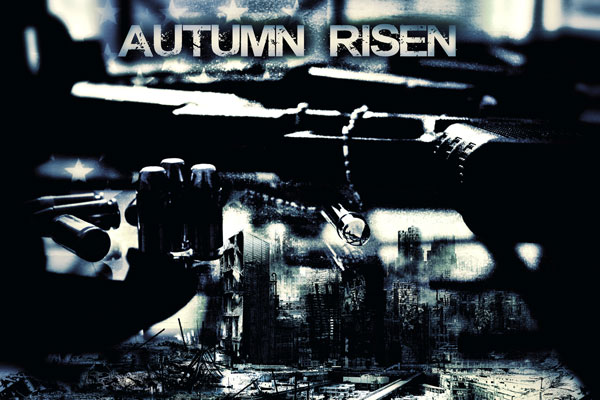
This sets the backdrop for the novel. The story focuses on a man named Jonas (Jon) Lassiter and several of his companions. Jonas lives far enough away from the metropolitan areas to have been spared both the infection and the nuclear blasts. He and his friend Caleb Walker are both avid shooters and outdoorsmen and have been slowly storing survival supplies away over the past few years as a contingency, always hoping that the worsening situation in the country would take a turn for the better, but being prepared for it to take a turn for the worse. They are now faced with the latter scenario as a stark reality.
Jim: How important is the graphical element to the story?
JM: The graphical element is really KEY for this book in my honest opinion. The story itself will conjure some great mental imagery, but to be able to see it right there on the page the way I envisioned while writing it, and to be able to convey that graphically to the reader as well as with the written word, it’s really a project that I’m incredibly passionate about. In fact this is THE passion project of my artistic career, you could easily say. I’ve gone to such lengths to try and get authenticity in both the imagery and in the writing. Let me clarify what I mean by that. On the imagery side, I’m attempting something I’ve never done before, which is to seamlessly bring together 3D, 2D, and photographic elements into something that I can only visually describe as “Surreality”.
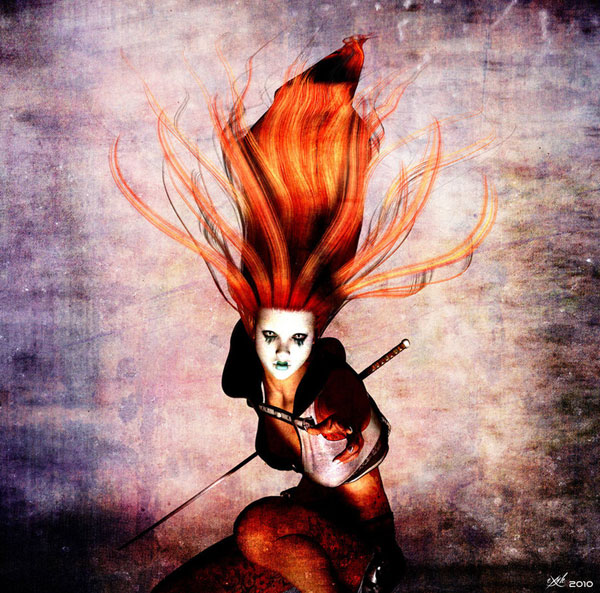 It’s a daunting task to say the least, but a rewarding one none the less. In order to accomplish this, I’ve had to gather the most realistic digital assets for the characters that will be entirely digital, and for the characters who are completely or mostly photographic I’ve had to do the same. Now, it’s one thing to buy a 3D AK-47 model for around $8.00…but it’s another entirely to buy an actual assault rifle for photo shooting …but I did it anyway, that’s how dedicated to realism I am in this project. In fact, the majority of photographic elements you see in the book are the real deal…guns, knives, bullets, tomahawks, canteens, tactical vests, radios, throat mic’s, laser sights, machetes, bowie knives, water filtration devices, gas masks, canteens…all the real deal. And no, don’t ask me the budget for the photo shoots, lol 🙂
It’s a daunting task to say the least, but a rewarding one none the less. In order to accomplish this, I’ve had to gather the most realistic digital assets for the characters that will be entirely digital, and for the characters who are completely or mostly photographic I’ve had to do the same. Now, it’s one thing to buy a 3D AK-47 model for around $8.00…but it’s another entirely to buy an actual assault rifle for photo shooting …but I did it anyway, that’s how dedicated to realism I am in this project. In fact, the majority of photographic elements you see in the book are the real deal…guns, knives, bullets, tomahawks, canteens, tactical vests, radios, throat mic’s, laser sights, machetes, bowie knives, water filtration devices, gas masks, canteens…all the real deal. And no, don’t ask me the budget for the photo shoots, lol 🙂
Then of course the final step is compositing the digital and photographic elements together and finding a common visual style to render the images in. I’m currently experimenting with the specifics of that, but as you can see from the concept art on my website, the art is very bleak…very desaturated and gritty. I wanted the images to convey the same sense of despair and desolation as the written words. In that respect they are very synergistic.
Jim: How long has Autumn Risen been in the works, and all things going well, when could we expect to see it?
JM: In terms of a release date on this project, I’m shooting for a hard deadline of June 2014 to be released on Amazon.com in both print format and electronic e-book/Kindle format. Obviously I’ll make that earlier if at all possible of course, but given the difficult nature of what I’m doing here I have to be realistic. I also want to take a moment just to thank the other half of my team at Exyle Studios, my awesome wife Angelika, without whose patience and photographic talents this project wouldn’t be possible.
Jim: You do a lot of texturing and have touched on digital painting. Are these skills that you have developed because of your work with 3D arts, or is this an extension of existing traditional drawing/painting skills?
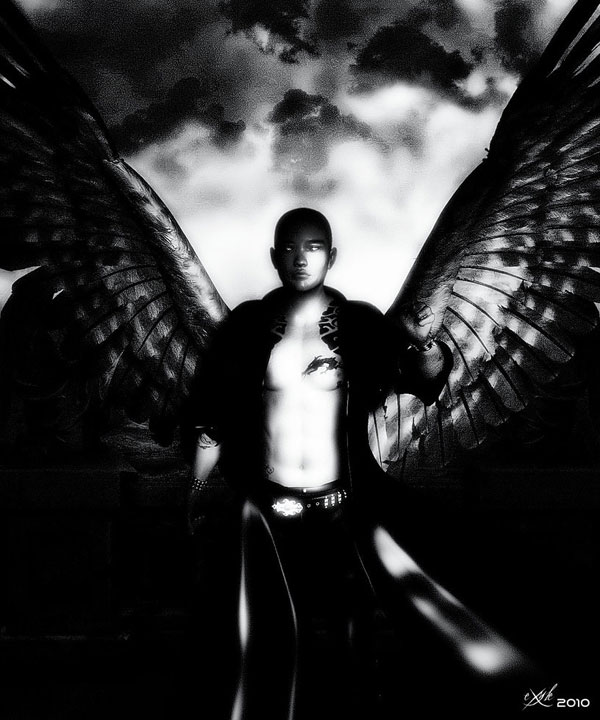 JM: Texturing has been essential to my other great love, which is custom 3D character creation for DAZ 3D’s various male and female models (M4, V4, Genesis, etc.). The more time you spend understanding texturing, bump maps, specular maps, Sub Surface Scattering and shader nodes in general the more doors will open up for you in creating the characters you’ve always dreamed about bringing into reality. As far as digital painting, that’s come about primarily for two reasons; one is to enhance my final images with post work and the other has been for adding fine details to custom character skins. I have dabbled some in just straight out attempting to paint elements digitally, but I consider this a secondary skill set that augments the rest of what I do. I basically have the philosophy that you can never have too much knowledge in your field / art or too many skill sets. I feel it makes me a more well-rounded artist.
JM: Texturing has been essential to my other great love, which is custom 3D character creation for DAZ 3D’s various male and female models (M4, V4, Genesis, etc.). The more time you spend understanding texturing, bump maps, specular maps, Sub Surface Scattering and shader nodes in general the more doors will open up for you in creating the characters you’ve always dreamed about bringing into reality. As far as digital painting, that’s come about primarily for two reasons; one is to enhance my final images with post work and the other has been for adding fine details to custom character skins. I have dabbled some in just straight out attempting to paint elements digitally, but I consider this a secondary skill set that augments the rest of what I do. I basically have the philosophy that you can never have too much knowledge in your field / art or too many skill sets. I feel it makes me a more well-rounded artist.
Jim: You currently have one character, Ivy (for Victoria 4), on the market at Content Paradise. How did you find the process of putting Ivy together and off to market? What are the highs and lows?
JM: Ivy was a lot fun to create and also a challenge at the same time to put together in a market package. I think it’s the little things that make putting a character package together time consuming. User’s (and the broker for that matter) expect a certain level of quality these days, meaning if you have 15 different nail color options and 12 different eye options, you better have a shiny rendered .png thumbnail image properly portraying that option in the pose or materials menu. Same goes for everything else in the package…props, poses, lights, you name it. I know there are some thumbnail utilities out there, but when it comes down to it, if you want a professional look for those menu items it comes down to a lot of renders and cropping…and some Photoshop layering for text, etc. I think I dread doing the menus and “read me” files more than creating the textures and morphs, lol :). But at the end of the day it’s very rewarding to see your product finally out there on the market and people buying it and enjoying it. Content Paradise was a nice test market for me…made it fairly easy to jump in and see how the process would go. Now that I’ve been through it and understand how things go I’m looking to get on board with Renderosity…once I have finished up “Autumn Risen” and am taking a much needed break from the novel writing that is :).
Jim: What would you say to artists hobbyist, or otherwise interested in getting into the content creation game?
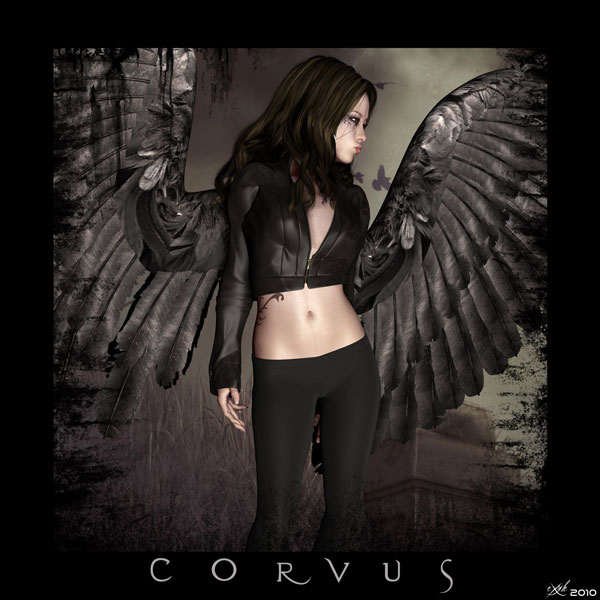 JM: I’d say first of all, make sure you have a solid understanding of the particular model and software you are working with (i.e. M4 in Poser, Genesis in Daz Studio, etc.). Unless you are well versed in modelling and texturing, you will probably want your first endeavour to begin with a merchant resource pack. Having a base skin that is pre-mapped to your specific model will save you many hours of frustration that you probably don’t need on your first attempt, lol. It’s key to understand how to place these files in the directory structure of your runtime, and then how to reference them in the surface editor / material room.
JM: I’d say first of all, make sure you have a solid understanding of the particular model and software you are working with (i.e. M4 in Poser, Genesis in Daz Studio, etc.). Unless you are well versed in modelling and texturing, you will probably want your first endeavour to begin with a merchant resource pack. Having a base skin that is pre-mapped to your specific model will save you many hours of frustration that you probably don’t need on your first attempt, lol. It’s key to understand how to place these files in the directory structure of your runtime, and then how to reference them in the surface editor / material room.
Mapping the right file to the right body part is only half the battle though in the texture department though 🙂 Understanding the advanced shader properties such as specularity, glossiness, etc. can make an enormous difference in achieving the look you are after. This is something that only comes with time and experimentation. If you’re like me and have a flare for the “not so human” type of characters, I would HIGHLY recommend picking up a copy of Filter Forge 3.0. This program allows you to generate seamlessly tiled textures for just about anything you can imagine…alien like skin, reptile scales, animal fur patterns, tech patterns…sky is the limit.
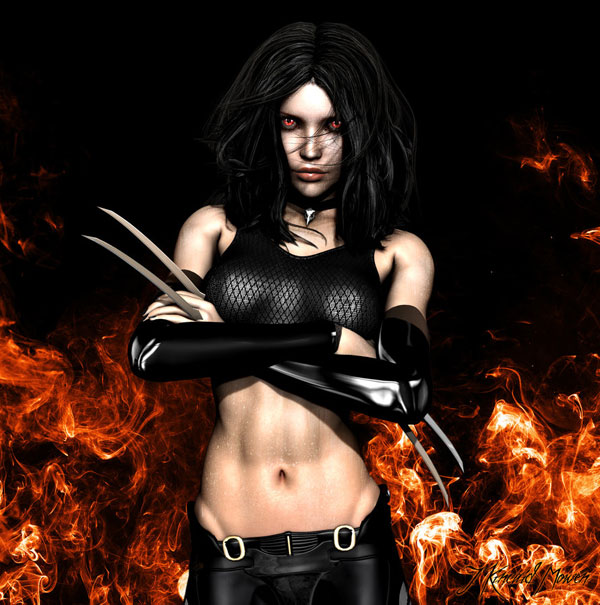 Lastly, reading up creating morph injections for the custom body & head you’ve created is essential (and sometimes requires a third party utility depending on which render software you are using). It can seem daunting at first, but stick with it and tackle it one piece at a time. Don’t try to see the whole picture at once or it might be overwhelming when you are first starting out. One final note, don’t overlook bump / displacement mapping. That can be the difference in a texture looking flat and fake and it looking like a million bucks.
Lastly, reading up creating morph injections for the custom body & head you’ve created is essential (and sometimes requires a third party utility depending on which render software you are using). It can seem daunting at first, but stick with it and tackle it one piece at a time. Don’t try to see the whole picture at once or it might be overwhelming when you are first starting out. One final note, don’t overlook bump / displacement mapping. That can be the difference in a texture looking flat and fake and it looking like a million bucks.
Jim: As well as Poser, you also make regular use of Vue and DAZ Studio. Does Autumn Risen contain work created with all three programs? If so is there a specific workflow, such as rendering being done primarily in a certain app while posing is done in another?
JM: Honestly, Autumn Risen is using just about everything I have in the toolbox, lol . A lot of thought went into which tool was appropriate for which purpose, and honestly Poser, DAZ Studio and Vue (amongst a few others) all have a place in this workflow. Just to give an example, for the character Serdar, I needed a 12 year old half Turkmen / half Russian boy. Obviously I don’t have one of those at my house, lol, so I had to create one. The question came down to which software can give me the best results on that.
In a nutshell, DAZ Studio and then Genesis figure won hands down on this one. Simply put, Genesis allowed me to take the basic male figure, age regress him down to about 12 years of age using the child morph, apply a slightly darker complected skin which was originally UV mapped for M4, and then auto-fit genesis clothing that scaled 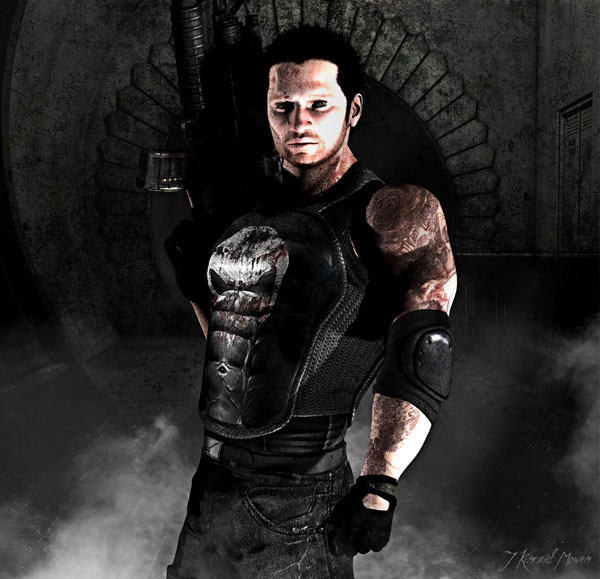 perfectly to the custom figure I had created. I also had to go through about 15 sets of eye textures before I found one that had the right “realism” to it, and the ethnicity head morphs allowed me to adjust the facial features to get the correct look for the boy given his heritage. Throw in the Ubersurface 2 shader and several hour’s worth of custom tweaks to the skin and lighting and…voila. While I love Poser and have many more years experience working in it, it just wasn’t the right tool for this particular character. Could I have done it in Poser? There were ways, yes, but more of a headache than I was prepared to deal with and probably yielding clothing issues (i.e. not being able to dress the character with the clothes I desired).
perfectly to the custom figure I had created. I also had to go through about 15 sets of eye textures before I found one that had the right “realism” to it, and the ethnicity head morphs allowed me to adjust the facial features to get the correct look for the boy given his heritage. Throw in the Ubersurface 2 shader and several hour’s worth of custom tweaks to the skin and lighting and…voila. While I love Poser and have many more years experience working in it, it just wasn’t the right tool for this particular character. Could I have done it in Poser? There were ways, yes, but more of a headache than I was prepared to deal with and probably yielding clothing issues (i.e. not being able to dress the character with the clothes I desired).
But now, flash forward to two weeks later and I’m running a test on an environmental piece…actually a piece of architecture which is lit from above through a hole in the ceiling. I load the same scene up in Poser and in DAZ Studio. I spend about an hour fiddling between the two. I’ll say that personally I have better luck getting the lighting I want faster in Poser than in DS. Now that may boil down to a matter of experience…maybe not. Bottom line here was I got the look I wanted in Poser within that hour’s time, and felt no need to continue pursuing the test in DS. There are also some characters which will be based on the M4 and V4 models which are just much easier and faster for me to work with in Poser and I know I’ll get superior results there just because of my familiarity with them.
As for Vue 11, it’s pretty much indispensable for creating those realistic outdoor and landscape scenes, or even when you need something as simple as a photorealistic sky to composite into a multi-part image. All these years and Vue still never ceases to amaze me with the things it can do. I’ve seen images done that I couldn’t distinguish from a photograph. It’s simply a stunning program and even after working 5 different versions of it personally I still feel like I’m barely scratching the surface of what it can do.
Jim: If I recall right, Genesis is one of the big selling points for DAZ Studio, as far as you’re concerned. Is this the only reason you use DS, and is DSON a potential fix for you as a Poser user?
JM: I can sum this one up pretty briefly 🙂 Genesis AND auto-fit are the key selling points for DAZ Studio, personally speaking. Quite simply, Poser just doesn’t have these. I can’t take one figure and mix in the DNA of 5 others and come up something completely unique in 2 minutes…and then fit and outfit to it PERFECTLY with the click of a button…it just can’t be done in Poser. That being said I do prefer a lot of things with Poser’s lighting rig, render engine, material room, shader nodes, etc. Even like the Sub Surface Scattering better. But when i need something totally custom and I need clothes to fit to it…clothes that were in no way shape or form MEANT to fit to it, I’m going to go with DAZ Studio.
As far as DSON, I’ll just say I’m not a fan 🙂 I’m glad that DAZ went the extra mile to try and bridge the gap between Genesis and Poser, but it really only works when folks have already created converted materials with the Poser Companion Files, etc…and even then the render’s just don’t look natural to me. They don’t look like they were done with Poser’s shader tree…they don’t look like they were done with DAZ Studio’s shader tree…they just don’t appeal to me. I’d rather work natively in one program or the other. It’s a nice gesture, it just doesn’t suit the way I work.
Jim: Is there stuff DAZ Studio users are simply missing out on?
JM: Well, if by that you’re meaning in comparison to what Poser offers [bingo!]? Since the release of Daz Studio version 4.6 Pro I’d honestly say no. You now have a very comparable program which just took care of the last few missing features (proper Sub Surface Scattering), and we’ve already discussed the various advantages you get in studio. You can render comparably gorgeous images in either software at this point. My one gripe with studio would be the fact that they still haven’t taken the time to put a 300 ppi resolution option in the render engine. It’s fixable in Photoshop, but this should have been addressed by now. Any images being created for print should always be 300 ppi.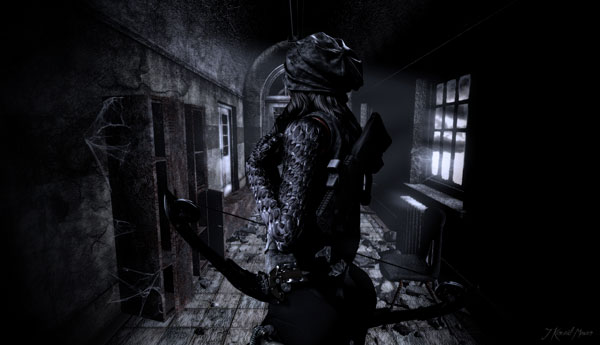
I think the only thing I can say that either a DAZ user or a Poser user is “missing out on” would be custom content (i.e. something that only works in one software or the other). For example, I think part of the reason I have a much easier time lighting in Poser is thanks to the IDL studio product created by Colm Jackson at Runtime DNA. It’s simply the best lighting system I’ve ever used, and so EASY to work with too. There simply isn’t an equivalent of this product that I know of at this point because these lights actually have nodes attached to them, something that wouldn’t convert to DS. I think probably the closest equivalent would be the UberLight system. I have the best results with it in DS. Other than that, I think poser users are getting the short end of the stick these days on content, as you can take an outfit made for V4 and import it into DS, click auto-fit, and in most cases, you’re golden. However a piece of clothing made for Genesis…you’re not bringing that in to put on V4 in Poser, lol. You’ve still got DSON, but…it’s not the same.
Jim: Let’s change gears for the last few questions. You have a policy in place whereby 75% of income from your commission projects is passed on to 3 charities: Compassion International, The Defender Foundation, and Angels of East Africa. Obviously this isn’t a token feel-good sum. What is it about these particular organisations and causes that lead you to the decision to donate such a large proportion?
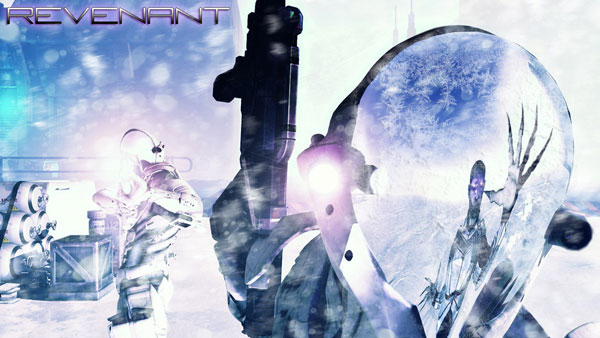 JM: Well it’s simple, really. I feel like I have been very blessed with my lot in life, and there are lot of people out there who have genuine needs. In my younger years it wasn’t something I gave a lot of thought to, regretfully. As I grew older and matured, I had this overwhelming feeling that I wanted my life to be about more than just achieving goals, or “The American Dream” or some such nonsense. Even as I was steadily working towards creating art projects that I’m embarking on now, which are commercial projects and ultimately are for entertainment purposes for the end user, I still wanted those projects to somehow have a greater meaning. One day it hit me right between the eyes…I said to myself, I’m not doing this for money…or fame…or any of that…it never has been about that. I have a great career that supports me and my family with more than we need and basically funds my studio endeavours free and clear of any debt. So when the studio reaches that point of finally seeing returns on the years of hard work poured into it, why not make that money count…for real?
JM: Well it’s simple, really. I feel like I have been very blessed with my lot in life, and there are lot of people out there who have genuine needs. In my younger years it wasn’t something I gave a lot of thought to, regretfully. As I grew older and matured, I had this overwhelming feeling that I wanted my life to be about more than just achieving goals, or “The American Dream” or some such nonsense. Even as I was steadily working towards creating art projects that I’m embarking on now, which are commercial projects and ultimately are for entertainment purposes for the end user, I still wanted those projects to somehow have a greater meaning. One day it hit me right between the eyes…I said to myself, I’m not doing this for money…or fame…or any of that…it never has been about that. I have a great career that supports me and my family with more than we need and basically funds my studio endeavours free and clear of any debt. So when the studio reaches that point of finally seeing returns on the years of hard work poured into it, why not make that money count…for real?
As far as the particular organizations I’ve chosen, as you can see on the “Reskue” page on my site, Compassion International was a given for me as I’ve already been supporting two children through them (both orphans, one from Haiti, one from Ethiopia) for several years. I’ve written back and forth to these kids over the years and seen what kind of a difference it makes when one person cares enough to help another human being have the most basic things… food… clean water… a warm blanket… clothes even…stuff you and I take for granted. I get regular letters from the kids and a new picture once a year from Compassion. I’ve literally watched these kids go from appearing skinny and malnourished and poorly clothed to looking like healthy well fed kids with a smile on their face. To me that’s a sense of satisfaction that never fades. It’s not like a book or graphic novel that will be forgotten about in time… that person will always be grateful for your compassion, and you will ALWAYS be glad you made that choice.
The other two are organizations were handpicked because they strike a sympathetic chord in my heart. The Defender Foundation helps locate and rescue women and children that have abducted into human trafficking. I wasn’t aware of just how widespread this problem was until recent years. My wife comes from the other side of the world and she has educated me a lot about how these types of things happened in neighbouring countries, etc. Quite honestly in sickens me and enrages me at the same time. As far as I’m concerned, any group actively trying to combat this heinous crime and rescue as many as they can out of this life is worthy of my support.
Lastly, I was made aware of Angels of East Africa through the recent movie which you may or may not have seen, entitled “Machine Gun Preacher” (starring Gerard Butler). This movie portrays the true life story of Sam Childers, a man who grew up only a few hours away from where I did, and basically led a down and out life of crime for much of his early life. After some wake-up call type events he finally got his act together and started supporting his family, even started his own construction company and built a church. After hearing a minister speak about a mission trip to Africa, he felt compelled to go and lend his help and construction knowledge to some villages there. Through a series of events he was made aware first hand of the atrocities going on in Sudan, namely thousands of children being abducted and forced to be soldiers for a rebel army…some of them even being forced to kill their own parents, entire villages sometimes being slaughtered.
Long story short, Sam took it to heart and got involved with some of the local soldiers trying to protect the local kids from kidnapping and to build them a guarded orphanage. His work made a huge difference that continues today as hundreds of children are kept safe at his orphanage and he spends about as much time in Sudan as he does the U.S. But this didn’t come without a personal price. He got a price put on his head and earned the name “Machine Gun Preacher” because he slept with a bible in one hand and an AK-47 in the other.
In short, he put his life at risk many times over to help save these kids from a fate some would consider worse than death, being forced to murder and mutilate in order to save your own life. His own family was stressed to the breaking point, but they persevered, and held together. Sam and his family are, in my opinion, a testament in this day and age. Many people talk about making a difference, but few have the guts to put their own life on the line to save someone else’s…not just once, but almost on the daily. Not many people would move to a warzone to help save people they never met. So for that reason, Sam has my everlasting respect and my financial support as well.
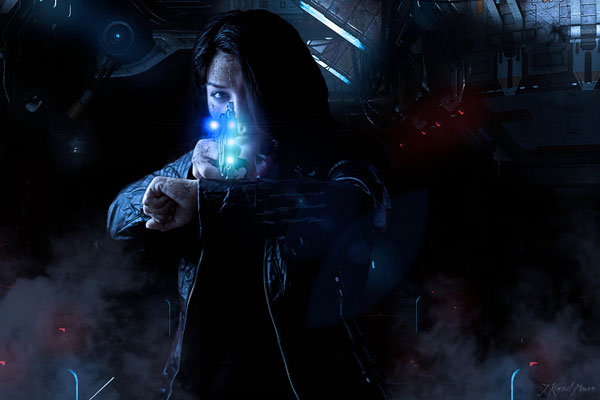 Jim: As you say on your website art is frequently a tool for raising awareness, but do you think it needs to play a more active role in addressing the concerns it raises?
Jim: As you say on your website art is frequently a tool for raising awareness, but do you think it needs to play a more active role in addressing the concerns it raises?
JM: That is a very good and profound question. Obviously art is great for getting a message out about a concern, but does it actually do anything about it? I think the answer there is it’s up to people to make a difference. Obviously creating awareness is the first step. Then after that I think its two fold. Are the people who are hearing the message loud and clear actually doing anything about the issue once they become aware? That really boils down to the individual and obviously can’t be forced. However I think the ones who have taken the initiative to raise awareness should feel compelled to take it a step further than just talk if they really are moved by the issue. Even if that means simply a small donation of money or time that would directly assist the cause. Again, that’s my personal opinion on the matter, and I’m a bit opinionated at this stage of my life, lol 🙂
Jim: How can you be contacted for those interested in commissioning your services?
JM: The studio website just opened its doors and there is a “Contact” tab which has a form that can be used to contact me via e-mail. I also list my e-mail address directly there (exylestudios@yahoo.com) as well as direct links to our Facebook and Twitter accounts and my DeviantArt page. Basically if you want to reach me, there are hundred different options there, lol 🙂

